The Gift of South Dakota
Subscriptions to South Dakota Magazine make great gifts!
Subscribe today — 1 year (6 issues) is just $29!
Ship in a Bottle
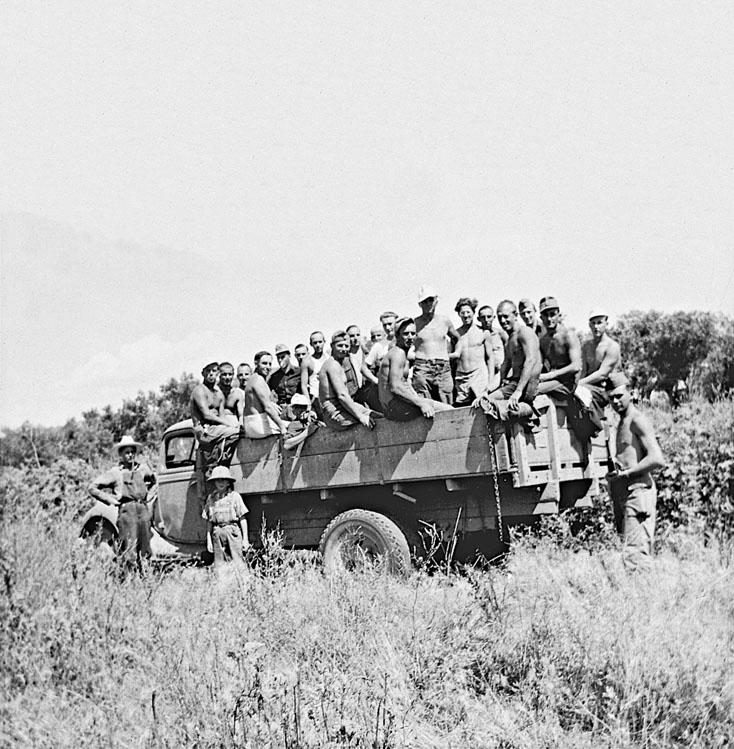 |
| German prisoners of war were put to work harvesting beets on Jack Rathbun's farm near Nisland. |
The war hit home for the Lungrens on a Sunday in December.
“I can remember the Sunday when the Japanese bombed Pearl Harbor,” says Don Lungren of Pierre, who grew up in a German-speaking home near Vale. “We went to church. We came home, and on Sunday, Dad always turned on the radio to hear what the markets were going to be on Monday morning in Sioux City. Most of the time we didn’t have anything to sell, but he had to know what the markets were.”
On that Sunday in 1941, his father tuned in the set, as always; but he might have let it stay on longer than usual. “They were making a lot of noise on that radio, I can remember that — yelling and stuff,” Lungren recalls. “Dad shut it off and he told Mom he was going to see Grandpa.”
Lungren’s father returned with a strict order: “Henceforth, we don’t speak German anymore.”
The attack on Pearl Harbor brought the United States into the war against Japan and its ally, Germany. Perhaps because of the mistreatment of ethnic Germans in the U.S. during World War I, and perhaps because of fears that Japanese and German speakers might be suspected of harboring sympathies with the enemy, the family stopped speaking German then and there.
That Sunday the Lungren children also realized Germans were on the other side of the war. And if they had any doubts that Germans were the adversaries, there was more proof. South Dakota would be one of the places where German prisoners of war were stationed as World War II dragged on.
The first prisoners of war arrived in America in May 1942. Historian Arnold Krammer, who has written extensively about the era, notes that not only Germans but also Italian and Japanese soldiers would spend time in American internment camps before the effort ended in July 1946.
“It is remarkable how many people don’t realize that we held nearly 425,000 German POWs (as well as 53,000 Italian and 5,000 military Japanese prisoners) in some 550 camps across the country. They worked in factories, hospitals and brought in the crops since our boys were overseas fighting in the war,” Krammer told us.
In South Dakota, German POWs ended up in parts of Meade and Butte counties doing fieldwork; in Yankton doing bank stabilization work on the Missouri River; in northeastern South Dakota; and in the Sioux Falls area.
“Every farmer in the valley here used German prisoners for a couple years,” says David Rathbun of Nisland, who was about 9 and 10 at the time his family benefited from POW labor in the fields. His brother Grove, four years older, would drive the truck when they went to fetch prisoners from the Civilian Conservation Corps camp at Orman Dam.
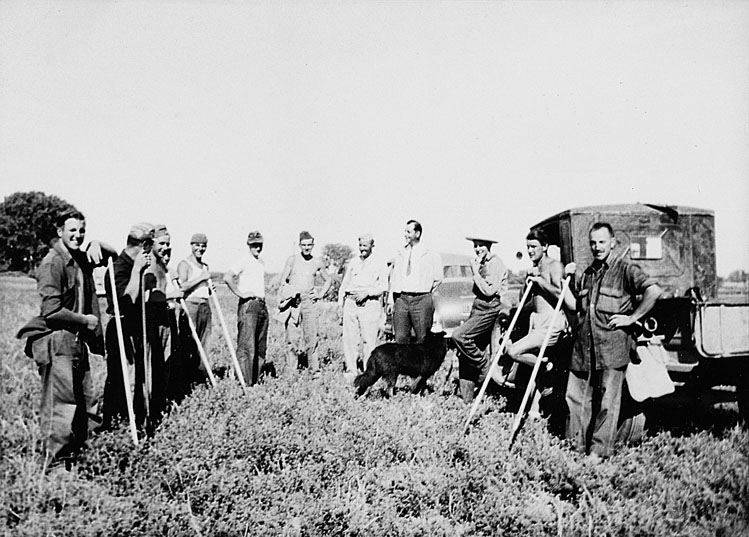 |
| The Rathbuns transported prisoners in their 1937 Ford beet truck. An American guard followed in the family's Model A pickup. |
“It was an old CCC camp in the ’30s, and the government turned it into a POW camp. It had machine gun towers and barracks and the whole works, big fence,” Rathbun says. “We’d go up in a truck, get a load of German prisoners, maybe 20 at a time, and haul them back to the farm and they’d work. They had to do so much in a day. I’ll give them credit, they were hard workers.”
During threshing, the German soldiers gathered bundles of barley, oats or wheat into wagons. In that era before combines were common, they also pitched bundles into the threshing machine.
With the sugar beets, the POWs took on many tasks: thinning the beets, hoeing them when they were bigger, pulling them and taking the tops off, loading them on trucks for transport to the railroad, where they were loaded on cars and taken to the factory for processing.
There were also prisoners stationed at nearby Fort Meade. The prisoners came from different sectors of the war, Rathbun recalls. “North Africa was the first ones we got. They came in ’43. That’s when we got Rommel’s Afrika Korps prisoners, and they were ornery bastards,” he remembers, referring to the German expeditionary force that fought in Africa under Erwin Rommel, one of Hitler’s favorite generals. “They were the old Nazi type. They stabbed one of their own prisoners, killed him with a butcher knife, up at Orman Dam at the prison camp because he was too friendly with American guards.”
Krammer says such incidents weren’t uncommon, though often concealed by the prisoners. “Almost every camp held a minority of die-hard Nazis who often terrorized the others and sometimes murdered one or two, listing the deaths as suicides.”
The prisoners stayed for growing season, and after harvest were moved to other parts of the country. “They shipped them all out, I don’t know what they did with them,” Rathbun says. “And then in ’44, we got prisoners from Normandy. They were just run-of-the-mill German soldiers. They were different. They were damn glad to be out of that war. They didn’t mind working in the beet fields.”
Krammer cites studies saying about 40 percent of German POWs were pro-Nazi. Eight to 10 percent were considered fanatics in their devotion to the Nazi cause, while another 30 percent were “deeply sympathetic.” But just as Rathbun suggested, many of the German POWs were not Nazis.
The prisoners were given small breaks to split up the hours of labor. “Our place had the Belle Fourche River running through it. If they got done early in their work, the guard would let them go swim in the river, and they really liked that,” Rathbun says.
There were even stories that the guard would take a dip with the prisoners now and then. “He did, actually,” Rathbun confirms. “I saw that happen. The guard went swimming and left a sergeant, German sergeant, sitting on the hillside looking for the colonel.”
Locals would often practice German with the prisoners. “There’s a lot of German around here. Our neighbors were Low German, I think, and the prisoners were High German, but they could understand each other. They’d talk all the time.”
Another mode of communication was the universal language of food and drink. Don Lungren recalls that his parents and grandparents, Germans themselves, coaxed extra labor out of the POWs.
“They would make a big 2- or 3-gallon pail of chicken noodle soup, and man, I’ll tell you, they could pick cucumbers twice as fast. And Grandpa, he made better than that. His bribe was that if they would look at the end of the trees, by the hog house, there would be some beer there if they would get those cucumbers picked today. They had them done by noon, I think.”
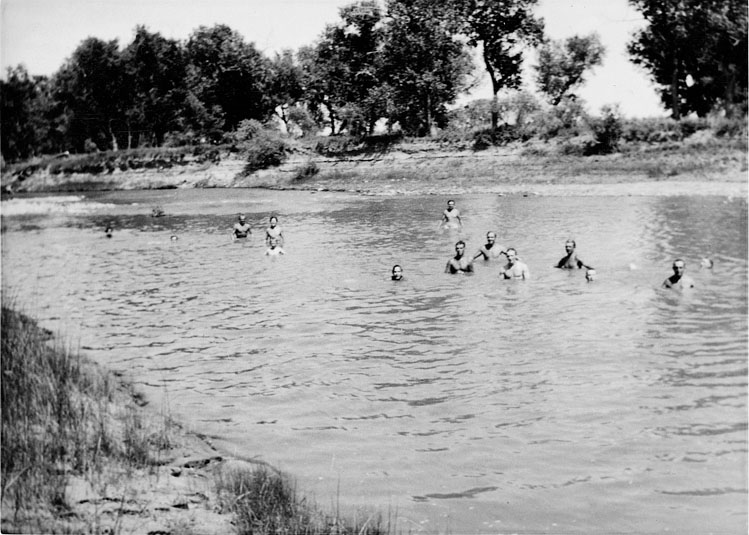 |
| After long days in the Butte County beet fields, prisoners sometimes enjoyed a swim in the Belle Fourche River. |
Lungren said other locals would do favors for the POWs. “My family and most of the German families always gave them a treat — chicken noodle soup from the old roosters and that sort of thing and beer at the end of the grove in the trees. The guard would come. Grandpa would loan the guard his shotgun and the guard could go shoot pheasants. And because the guard couldn’t get the pheasants home, I suppose Grandma cooked the pheasants and fed them to the prisoners.”
Sometimes the farmers got more than they asked. “Grandma told one of the prisoners she wanted some little cucumbers because she wanted to make baby dills,” Lungren said. His grandmother had business to tend to, but when she got back to the field, the Germans had picked two bushels of tiny cucumbers — far more than she needed. “We had baby dills for years.”
Marian Ruff added that for German-speaking families, even though many of them had immigrated to America from German communities in Russia, it was awkward having German POWs work in the fields.
“My family, like the other German families, was looked down on because of the war — because they were Germans,” she said. “With the POWs, I think we felt sorry for them because of the way they were treated. They would bring this truckload of guys out to the Vale area and they would have two armed soldiers with them with rifles in case they tried to escape. They were supposed to shoot them.”
The guards weren’t just for show, Krammer says.
“There were escapes aplenty, but most were caught within three days,” he notes. But, he adds that many prisoners quickly figured out they would be treated decently in America.
“Those assigned to American farms were well-treated and modern flea markets still have POW-made handicrafts which they gave to the children of farm families,” Krammer said.
That was the case in South Dakota, too, Marian Ruff said. “They were just really happy to get out of the prison situation and do something. Several of them put together some ships inside of wine bottles. We have one of those. One was given to my grandpa. Several of the families that these prisoners worked for ended up with one of these ships inside of a bottle. It always fascinated me because I had no idea how they did it. Someone said to me recently, ‘Well, they sawed the bottom of the bottle and put the ship in and sealed the bottom back on again,’ but I don’t know if that’s what they really did or not.”
And no one knows what it meant to a German soldier, either — building a ship inside a bottle in a prison camp to give to a German farmer in landlocked South Dakota.
David Ruff of Spearfish, Marian’s husband, grew up near Nisland during the war. He spoke German well enough to understand the German POWs who worked for his father and some of the neighbors.
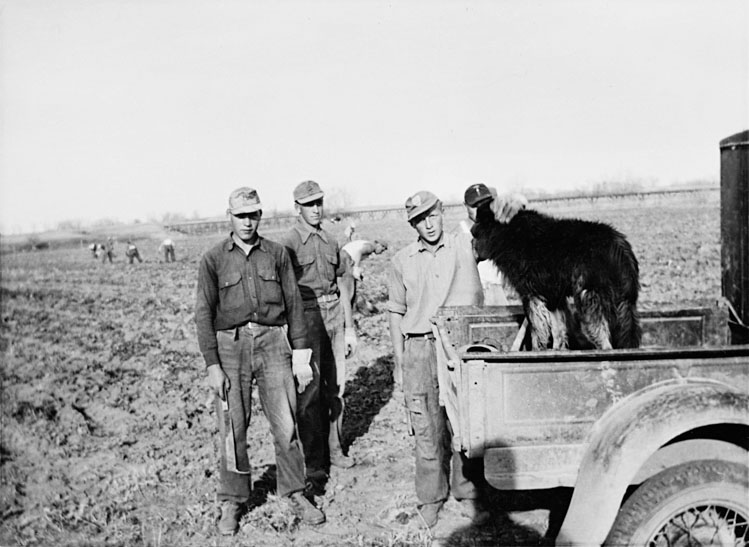 |
| The Rathbun family dog often provided canine companionship for Germans working the fields. |
“I often wondered if they didn’t have feelings knowing that they were in a country so far from their homeland and had people there that could speak their language. I think many of the prisoners were quite pleased to find that there were German-speaking people here. They were appreciative of the extra food that was given them and the friendliness of the farmers that they worked for.
“I don’t know if I personally asked one of them or what, but somehow or another in conversation, I learned from them that they were quite pleased with the treatment they were receiving here. I’m not sure exactly where they became prisoners of war, but they mentioned that when they were in France, they were required to drink out of the troughs that the livestock drank out of.”
POWs also made an impact on the other side of the state. Yankton-area historians Lois Varvel and Kathy K. Grow reflected on the German POWs stationed in Yankton in their 2001 book, The Bridge We Built: The Story of Yankton’s Meridian Bridge. They noted that the Yankton Press & Dakotan reported on April 3, 1945, the arrival of the first contingent of German POWs from the Afrika Korps to take part in Missouri River bank protection work. Officials wouldn’t tell the newspaper how many German POWs would come to Yankton, citing policy on POWs, but the newspaper understood they would make up “a sizable force.”
The POWs worked on a project to make sure the main flow of the Missouri River steered clear of the city of Yankton’s water intake. The work had side benefits for the Meridian Bridge. “We had prisoners of war trucked in from Algona, Iowa, and they did revetment work on the Nebraska shoreline. That was their contribution to protecting the Meridian Bridge,” Varvel says.
After the war ended, most of the 375,000 German POWs went back to Germany — but not all stayed there. Some liked what they had seen of life in America. The United States didn’t track the number of former German POWs who ended up immigrating to the land of their captivity; but it was substantial. Krammer notes that John Schroer, a former POW who immigrated to America after being held as a POW in Alabama, estimated about 5,000 POWs made a similar move. Some reportedly returned to South Dakota, too, where the enemy they had fought showed them decency and kindness in victory.
Editor’s Note: The tally of German prisoners of war in South Dakota at any one time during World War II was a floating figure because they rotated in and out of different states depending on the local harvest and other demands. Curt Nickisch, a South Dakota Public Broadcasting journalist at the time, wrote a story for South Dakota Magazine in 2001 in which he reported the number at more than 1,200 POWs through 1944 and 1945. There are also several books available, including Nazi Prisoners of War in America by Arnold Krammer. This story is revised from the March/April 2018 issue of South Dakota Magazine. To order a copy or to subscribe, call (800) 456-5117.




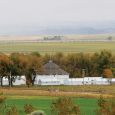


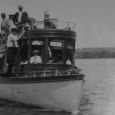


Comments